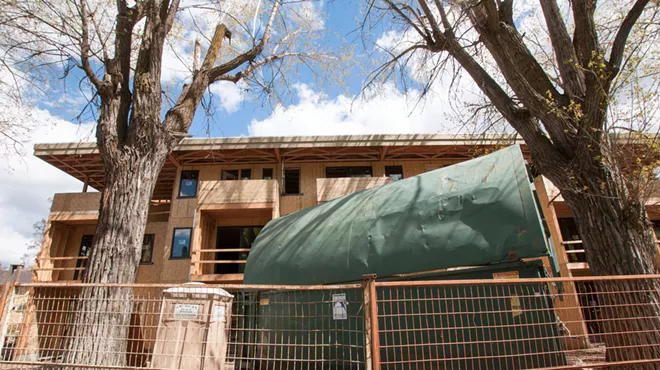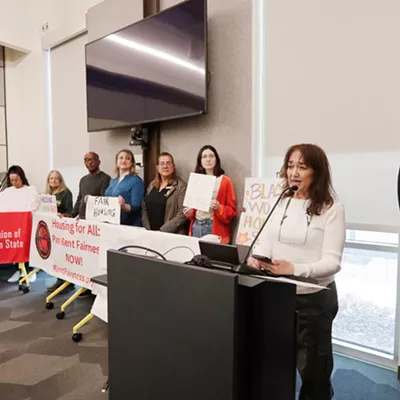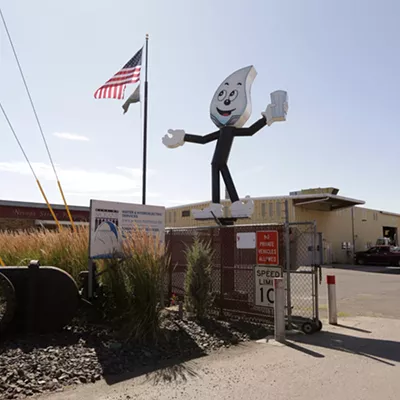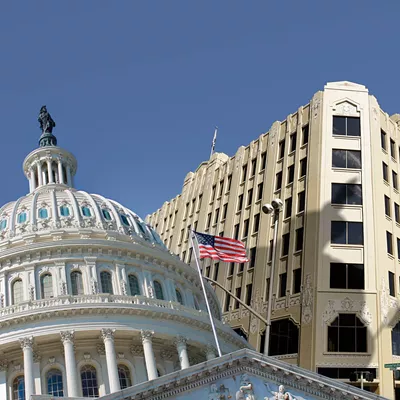
Some sidewalks have cracks. The sidewalks near the intersection of 12th Avenue and Adams Street look more like they have seismic fault lines.
The sidewalks buckle and roll, jutting up and down like the jagged bumps of a motocross course. The roots of century-old trees — London planes and sycamores and Norway maples — trapped between rock retaining walls and the street, have shoved upward, lifting concrete slabs off of the sidewalks, tilting them into crazy angles. These sidewalks have potholes too, where slanted concrete funnels water into deep puddles. The sidewalks are so broken they're nearly impossible to shovel in the winter.
Patricia Hansen, president of the Cliff/Cannon Neighborhood Council, says the neighbors outright laughed when they were told that the standard of the American Disabilities Act required the difference in height between one sidewalk segment and another to be a half-inch or less.
Some sidewalk segments, Hansen says, jut up by as much as 15 inches.
"Literally, you're hiking over sections of sidewalk," Hansen says. "There's more than a foot of separation."
It's not just the issue of neighborhood pride, about neighbors cringing as they think of visitors to a beautiful Airbnb location trekking across the broken sidewalks from the nearby bus stop. It means that sidewalks can't be easily used by kids riding bikes, disabled neighbors or the elderly.
Hansen says they used to hold the neighborhood block party on 10th Avenue near Jefferson Street, where the streets slope and the sidewalks are in shambles. But at the 2014 block party, she says, three elderly people fell.
In the aftermath of last month's ouster of Spokane's street director, the city administration and city council have discussed a major overhaul of the way that the department fills potholes and plows snow. Yet for years, neighborhood councils have been beating the drums about broken sidewalks on the edges of those streets.
Now, they're looking at a way to finally pay to fix those sidewalks.
At their March 28 meeting, the Pedestrian Transportation and Traffic Committee of the neighborhood councils' Community Assembly will begin to sketch out a framework for a property tax levy to not only repair broken sidewalks, but add new ones.
"I knew the band-aid approach has not been working," says Hansen, "and will not continue to work in the future."
BROKEN PATHWAYS
It's not that the city doesn't fix some sidewalks. Sure, under the previous street bond, a street would be replaced while leaving the crumbling sidewalks at its edges untouched. That's changed with the street levy passed in 2014. Now rebuilt streets mean rebuilt sidewalks, too. But other than adding ramps required by the Americans with Disabilities Act, the city hasn't been doing full sidewalk replacements when it makes more minor street repairs.
"We're falling farther behind," says City Councilman Breean Beggs.
Technically, it's not the city's job to fix residential sidewalks, no matter how broken. City code explains that it's the job of the property owner to repair the sidewalks in front of their properties. But most neighbors aren't eager to shell out the $5,000 to $10,000 required to replace them, and the city hasn't been raring to force its citizens to pay for sidewalk repairs.
"That's, politically, a little bit unpalatable and unrealistic," Beggs says. But if the city leaves sidewalks broken, it can be on the legal hook if somebody gets injured.
Last spring, Beggs says the city administration floated a plan to begin requiring residents to fix dangerous sidewalks outside their property and use a pool of $40,000 to offer loans to low-income residents who couldn't afford the repairs.
"$40,000?!" Beggs says, chuckling. He says he went for a morning jog around his South Hill neighborhood and surveyed the damage. Such a sum wouldn't even begin to fix the sidewalks in his district, he concluded, much less the whole city.
At the same time, a group of neighborhood councilmembers across the city was meeting to discuss the sidewalk problems. Historic neighborhoods like Cliff/Cannon and Browne's Addition could point to sidewalks ravaged by tree roots and time. Meanwhile, many newer city neighborhoods that were annexed from Spokane County, like Five Mile Prairie, didn't have sidewalks to begin with.
"Bless their black hearts, they never required sidewalks," says Paul Kropp, chairman of the Pedestrian Transportation and Traffic Committee, about Spokane County. "It's ludicrous."
But the city has few dedicated funding streams to pay for sidewalk repairs. Ten percent of license tab fees raised for the Transportation Benefit District go toward residential sidewalks and other pedestrian improvements. Some of the traffic-calming revenue raised through the city's red-light camera programs go toward sidewalk improvements. Otherwise, neighborhoods generally rely on federal Community Development Block Grants to fix their worst sidewalks.
"We really work closely with neighborhoods to invest their CDBG funds on issues that matter to them," says Jonathan Mallahan, director of the city's Community & Neighborhood Services Division. "We very much want to have a way that's affordable to find a path to have a great pedestrian infrastructure."
But the block grant funds can only be used in low-income areas of the city. Those boundaries, defined by the federal government, can sometimes seem downright absurd to neighborhoods.
Kai Huschke, chair of the Latah/Hangman Neighborhood Council, says that the block grant funds allowed for the construction of sidewalks along one side of Inland Empire Way, but not the other.
"We had talked to the Office of Neighborhood Services," Huschke says. "This is crazy. How do you draw a boundary that doesn't include both sides of the street?"
Even neighborhoods that reliably receive the grants say they can feel like only a drop in the bucket. The Cliff/Cannon neighborhood gets about $35,000 a year in block grant funding, enough to fix up sidewalks in front of about four properties a year. It would take a century to fix all the Cliff/Cannon neighborhood sidewalks using those funds, Hansen calculates.
And there's not a guarantee that Community Development Block Grants will even exist next year. In order to free up more funding for defense spending, President Donald Trump's proposed budget would eliminate the CDBG program entirely. If that budget passes, Spokane would lose one of its few tools for funding sidewalk repairs.
THE COST OF CONCRETE
Beggs himself doesn't quite commit to supporting the sidewalk levy fully, at least not yet. He says that voters deserve to make the decision themselves.
"It's my overall theme of 'Let the community choose,'" he says.
Beggs asked that questions about the sidewalk levy be included on a survey sent out to Spokane residents in December. More than three-quarters of Spokane residents surveyed supported the creation of a new program to fund streets, the survey found.
The sticking point, however, was price. Less than half of those surveyed supported a property tax of $75 a year. But at an annual tax level of $60 or less, the majority of those surveyed supported it. Over a decade, that would raise about $50 million. That's only a fraction of the more than $230 million required to simply add sidewalks to the streets that need them in the city of Spokane, but Beggs says it's a start.
"That would put a dent in it," he says. The vote could be as soon as November.
Yet the sidewalk levy isn't something being considered in isolation. The city council is also weighing whether it should spend more tax money on plowing streets, filling potholes and fighting crime. Beggs has also brought up the possibility of a tax on sugary beverages as a way to raise funds to address property crime.
Hansen says she isn't opposed to funding those other priorities.
"But you cannot risk how this city looks by letting the sidewalk [levy] fall off of the radar," Hansen says. There are consequences, she argues, to letting pedestrian walkways fall into disrepair. Disorder, she argues, leads to more disorder:
"In an area like this, that has sidewalks like this — it doesn't make it look like Better Homes and Gardens material. It starts to attract crime." ♦
























